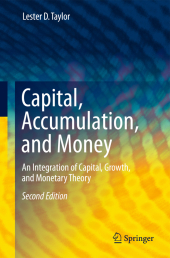 Neuerscheinungen 2014Stand: 2020-02-01 |
Schnellsuche
ISBN/Stichwort/Autor
|
Herderstraße 10
10625 Berlin
Tel.: 030 315 714 16
Fax 030 315 714 14
info@buchspektrum.de |

Lester D. Taylor
Capital, Accumulation, and Money
An Integration of Capital, Growth, and Monetary Theory
2. Aufl. 2014. xxvii, 278 S. 5 Tabellen. 235 mm
Verlag/Jahr: SPRINGER, BERLIN; SPRINGER US; SPRINGER 2014
ISBN: 1-489-99077-1 (1489990771)
Neue ISBN: 978-1-489-99077-8 (9781489990778)
Preis und Lieferzeit: Bitte klicken
This book will benefit individuals interested in a non-mathematics-based theory of capital. Coverage includes the factors that led to the financial market turmoil of 2008. Additionally, the author proposes ideas for avoiding economic crises in the future.
Capital, Accumulation, and Money: An Integration of Capital, Growth, and Monetary
Theory is a book about capital and money. A root concept of capital is formulated that allows for most existing concepts of capital to be unified and related to one another in consistent fashion. Capital and monetary theory are integrated in a non-mathematical framework that imposes a number of constraints on the macro behavior of an economy, constraints which make for the straightforward understanding of such concepts as the real stock of money, real-balance effects, and the general price level. New and illuminating insights are also provided into aggregate supply and demand, natural and money rates of interest, the relationship between real and monetary economies, and economic growth and development.
This fully expanded, revised, and updated edition features important new material on a variety of timely topics, including:
Factors leading to the financial meltdown and turmoil of 2007-09;
Why bubbles form in asset markets and how these impact on the real economy;
The importance of a lender-of-last-resort in times of financial stress;
Future financing and funding of the U. S. Social Security System.
Additionally, the author offers a number of ideas for alleviating the severity, if not the avoidance altogether, of financial crises in the future. This is a book for those -- students (both graduate and undergraduate) and their teachers, investors, and the informed public -- who want an understanding of how economies and financial markets function, without an advanced degree in mathematics.
Premises and an Overview.- Myros and Other Concepts and Definitions.- The Macroeconomic Framework.- Interest and Money.- Production and Investment.- General Price Level and Inflation.- Capital Values, Wealth, and Related Topics.- Macroeconomic Equilibrium and Employment.- Capital Theory in Perspective.- Opportunity and Sunk Costs.- Trade, Transfers, and Monetary Overhangs.- Questions Related to Consumption and Saving.- Questions Related to Economic Growth.- Themes and Counterthemes: Fluid Capital in Retrospect.- Background and Tools for Understanding and Dealing with Recurrent Financial Crises.- Booms, Busts, and Financial Panics: The Financial Meltdown of 2007-2009.


